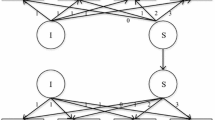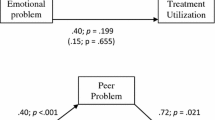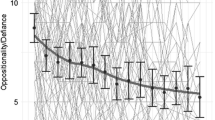Abstract
We examined the potential impact of negative peer influence within a treatment-focused residential care setting. Subjects were 712 youth consecutively admitted to a large residential treatment program (9–19 years of age). Based on Diagnostic Interview Schedule for Children (DISC) scores, 247 (35%) of these youth qualified for a Conduct Disorder diagnosis at admission. The dependent measures were the number of DISC Oppositional Defiant Disorder (ODD)/Conduct Disorder (CD) symptoms and the sum of Conduct Problem behaviors observed daily for each youth. Both the Conduct Problem Behaviors and the ODD/CD symptoms for both CD and non-CD groups decreased over time. Youth with a CD diagnosis or who were female improved at a faster rate than their peers. The data analyzed in this study do not support a negative peer influence effect for antisocial youth placed in a treatment-focused residential care setting.

Similar content being viewed by others
References
Ainsworth, F., & Hansen, P. (2005). A dream come true—no more residential care. A corrective note. International Journal of Social Welfare, 14, 195–199. doi:10.1111/j.1468-2397.2005.00359.x.
Allen, J. P., Porter, M. R., & McFarland, F. C. (2006). Leaders and followers in adolescent close friendships: Susceptibility to peer influence as a predictor of risky behavior, friendship instability, and depression. Development and Psychopathology, 18, 155–172. doi:10.1017/S0954579406060093.
American Psychiatric Association. (1987). Diagnostic and statistical manual of mental disorders (3rd Revised ed.) Washington, DC: American Psychiatric Association.
American Psychiatric Association. (1994). Diagnostic and statistical manual of mental disorders (4th Revised ed.) Washington, DC: American Psychiatric Association.
Anglin, J. P. (2001, February). Staffed group homes for children and youth: Understanding their role and ensuring quality. Paper presented in the CWLC National Teleconference Series, Canada.
Arieli, M., Beker, J., & Kashti, Y. (2001). Residential group care as a socializing environment: Toward a broader perspective. Child & Youth Care Forum, 30, 403–414. doi:10.1023/A:1015321302983.
Beutler, L. E. (1998). Identifying empirically supported treatments: What if we didn’t? Journal of Consulting and Clinical Psychology, 66, 113–120. doi:10.1037/0022-006X.66.1.113.
Boxer, P., Guerra, N. G., Huesmann, L. R., & Morales, J. (2005). Proximal peer-level effects of a small-group selected prevention on aggression in elementary school children: An investigation of the peer contagion hypothesis. Journal of Abnormal Child Psychology, 33, 325–338. doi:10.1007/s10802-005-3568-2.
Bray, J. H., Adams, G. J., Getz, J. G., & Baer, P. E. (2001). Developmental, family, and ethnic in influences on adolescent alcohol usage: A growth curve approach. Journal of Family Psychology, 15, 301–314. doi:10.1037/0893-3200.15.2.301.
Burleson, J. A., Kaminer, Y., & Dennis, M. L. (2006). Absence of iatrogenic or contagion effects in adolescent group therapy: Findings from the Cannabis Youth Treatment (CYT) Study. The American Journal on Addictions, 15, 4–15. doi:10.1080/10550490601003656.
Chung, H. L., & Steinberg, L. (2006). Relations between neighborhood factors, parenting behaviors, peer deviance, and delinquency among serious juvenile offenders. Developmental Psychology, 42, 319–331. doi:10.1037/0012-1649.42.2.319.
Daly, D. L., & Dowd, T. P. (1992). Characteristics of effective, harm-free environments for children in out-of-home care. Child Welfare, 71, 487–496.
Daly, D. L., Thompson, R. W., & Coughlin, D. D. (1994). The relationship between length of stay and outcomes of residential care: A longitudinal study. Paper presented at the 7th FMHI Annual Research Conference, Tampa, FL.
Davidson-Arad, B. (2005). Fifteen-month follow-up of children at risk: Comparison of the quality of life of children removed from home and children remaining at home. Children and Youth Services Review, 27, 1–20. doi:10.1016/j.childyouth.2004.07.002.
Davidson-Arad, B., Englechin-Segal, D., & Wozner, Y. (2003). Short-term follow-up of children at risk: Comparison of the quality of life of children removed from home and children remaining at home. Child Abuse and Neglect, 27, 733–750. doi:10.1016/S0145-2134(03)00113-3.
Davis, J., & Daly, D. L. (2003). Girls and Boys Town long-term residential program: Training manual (4th ed.). Boys Town, NE: Father Flanagan’s Boys’ Home.
DeMuro, P. (2008). Why child welfare agencies should limit the role of residential care. Journal for Juvenile Justice Services, 4, 59–67.
Dishion, T. J., McCord, J., & Poulin, F. (1999). When interventions harm: Peer groups and problem behavior. The American Psychologist, 54, 755–764. doi:10.1037/0003-066X.54.9.755.
Dishion, T. J., Nelson, S. E., & Bullock, B. M. (2004). Premature adolescent autonomy: Parent disengagement and deviant peer process in the amplification of problem behaviour. Journal of Adolescence, 27, 515–530. doi:10.1016/j.adolescence.2004.06.005.
Dishion, T. J., & Stormshak, E. A. (2007). Child and adolescent intervention groups. In T. J. Dishion & E. A. Stormshak (Eds.), Intervening in children’s lives: An ecological, family-centered approach to mental health care (pp. 201–215). Washington, DC: American Psychological Association.
Dodge, K. A. (1999). Cost-effectiveness of psychotherapy for child aggression: First, is there cost effectiveness? Comment on Shechtman and Ben-David (1999). Group Dynamics: Theory, Research, and Practice, 3, 275–278. doi:10.1037/1089-2699.3.4.275.
Dodge, K. A., Dishion, T. J., & Lansford, J. E. (2006a). Deviant peer influences in intervention and public policy for youth. Social Policy Report, 20, 3–19.
Dodge, K. A., Lansford, J. E., & Dishion, T. J. (2006b). The problem of deviant peer influences in intervention programs. In K. A. Dodge, T. J. Dishion, & J. E. Lansford (Eds.), Deviant peer influences in programs for youth: Problems and solutions (pp. 3–13). Guilford Press: New York.
Dodge, K. A., & Sherrill, M. R. (2006). Deviant peer group effects in youth mental health interventions. In K. A. Dodge, T. J. Dishion, & J. E. Lansford (Eds.), Deviant peer influences in programs for youth: Problems and solutions (pp. 97–121). Guilford Press: New York.
Dore, M. M., & Eisner, E. (1993). Child-related dimensions of placement stability in treatment foster care. Child and Adolescent Social Work Journal, 10, 301–317. doi:10.1007/BF00758261.
Eddy, J. M., Whaley, R. B., & Chamberlain, P. (2004). The prevention of violent behavior by chronic and serious male juvenile offenders: A 2-year follow-up of a randomized clinical trial. Journal of Emotional and Behavioral Disorders, 12, 2–8. doi:10.1177/10634266040120010101.
Edwards, J. K. (1994). Children in residential treatment: How many, what kind? Do we really know? Residential Treatment for Children & Youth, 12, 85–99. doi:10.1300/J007v12n01_06.
Feldman, R. A. (1992). The St. Louis experiment: Effective treatment of antisocial youths in prosocial peer groups. In J. McCord & R. E. Tremblay (Eds.), Preventing antisocial behavior: Interventions from birth through adolescence (pp. 233–252). Guilford Press: New York.
Florsheim, P., Behling, S., South, M., Fowles, T. R., & DeWitt, J. (2004). Does the youth corrections system work? Tracking the effectiveness of intervention efforts with delinquent boys in state custody. Psychological Services, 1, 126–139. doi:10.1037/1541-1559.1.2.126.
Frankfort-Howard, R., & Romm, S. (2002). Outcomes of residential treatment of antisocial youth: Development of or cessation from adult antisocial behavior. Residential Treatment for Children & Youth, 19, 53–70. doi:10.1300/J007v19n03_04.
Frick, P. J. (2001). Effective interventions for children and adolescents with conduct disorder. Canadian Journal of Psychiatry, 46, 597–608.
Friman, P. C. (1999). Family-style residential care really works: Scientific findings demonstrating multiple benefits for troubled adolescents. Boys Town, NE: Boys Town Press.
Friman, P. C., Handwerk, M., Smith, L., Larzelere, R. E., Lucas, C. P., & Shaffer, D. M. (2000). External validity of conduct and oppositional defiant disorders by the NIMH diagnostic interview schedule for children. Journal of Abnormal Child Psychology, 28, 277–286. doi:10.1023/A:1005148404980.
Gehringer, R. G. (2006). The impact of IQ on symptom reduction in a midwestern residential group home setting using the Family Home Program. Dissertation Abstracts International Section A: Humanities and Social Sciences, 67(4), 1165A.
Gibbs, J. C., Potter, G. B., Barriga, A. Q., & Liau, A. K. (1996). Developing the helping skills and prosocial motivation of aggressive adolescents in peer group programs. Aggression and Violent Behavior, 1, 283–305. doi:10.1016/1359-1789(95)00018-6.
Gifford-Smith, M. (2005). Peer influence in children and adolescents: Crossing the bridge from developmental to intervention science. Journal of Abnormal Child Psychology, 33, 255–265. doi:10.1007/s10802-005-3563-7.
Gilman, R., & Handwerk, M. L. (2001). Undergraduate students’ perceptions of school psychology: Findings and implications. School Psychology Review, 30, 120–134.
Handwerk, M. L. (1999). New DISC developments: Use of the voice-DISC in a residential setting. Paper presented at the 46th Annual Meeting of the American Academy of Child and Adolescent Psychiatry, Chicago, IL.
Handwerk, M. L., Clopton, K., Huefner, J. C., Smith, G. L., Hoff, K. E., & Lucas, C. P. (2006). Gender differences in adolescents in residential treatment. The American Journal of Orthopsychiatry, 76, 312–324. doi:10.1037/0002-9432.76.3.312.
Handwerk, M. L., Field, C., & Friman, P. C. (2001). The iatrogenic effects of group intervention for antisocial youth: Premature extrapolations? Journal of Behavioral Education, 10, 223–238. doi:10.1023/A:1012299716053.
Hanish, L. D., Martin, C. L., Fabes, R. A., Leonard, S., & Herzog, M. (2005). Exposure to externalizing peers in early childhood: Homophily and peer contagion processes. Journal of Abnormal Child Psychology, 33, 267–281. doi:10.1007/s10802-005-3564-6.
Haynie, D. L., & Osgood, D. W. (2005). Reconsidering peers and delinquency: How do peers matter? Social Forces, 84, 1109–1130. doi:10.1353/sof.2006.0018.
Hektner, J. M., August, G. J., & Realmuto, G. M. (2003). Effects of pairing aggressive and nonaggressive children in strategic peer affiliation. Journal of Abnormal Psychology, 31, 399–412.
Kellam, S. G., Ling, X., Merisca, R., Brown, C. H., & Ialongo, N. (1998). The effect of the level of aggression in the first grade classroom on the course and malleability of aggressive behavior into middle school. Development and Psychopathology, 10, 165–185. doi:10.1017/S0954579498001564.
Kiesner, J., Poulin, F., & Nicotra, E. (2003). Peer relations across contexts: Individual-network homophily and network inclusion in and after school. Child Development, 74, 1328–1343. doi:10.1111/1467-8624.00610.
Kingsley, D. E. (2006). The teaching-family model and post-treatment recidivism: A critical review of the conventional wisdom. International Journal of Behavioral and Consultation Therapy, 2, 481–497.
Knutson, J. F., DeGarmo, D., Koeppl, G., & Reid, J. B. (2005). Care neglect, supervisory neglect, and harsh parenting in the development of children’s aggression: A replication and extension. Child Maltreatment: Journal of the American Professional Society on the Abuse of Children, 10, 92–107.
Larzelere, R. E. (1996). Inter-coder reliabilities and construct groupings for some important codes on the Daily Incident Report (NRI 001–96). Boys Town, NE: Father Flanagan’s Boys’ Home.
Larzelere, R. E., Daly, D. L., Davis, J. L., Chmelka, M. B., & Handwerk, M. L. (2004). Outcome evaluation of the Girls and Boys Town family home program. Education & Treatment of Children, 27, 130–149.
Lauritsen, J. (2005). Explaining patterns of offending across the life course: Comments on interactional theory and recent tests based on the RYDS-RIS data. The Annals of the American Academy of Political and Social Science, 602, 212–228. doi:10.1177/0002716205280152.
Lavallee, K. L., Bierman, K. L., Nix, R. L., & The Conduct Problems Prevention Research Group. (2005). The impact of first-grade “friendship group” experiences on child social outcomes in the Fast Track program. Journal of Abnormal Child Psychology, 33, 307–324. doi:10.1007/s10802-005-3567-3.
Lee, B. R., & Thompson, R. W. (2008). Comparing outcomes for youth in treatment foster care and family style group care. Children and Youth Services Review, 30, 746–757. doi:10.1016/j.childyouth.2007.12.002.
Lee, B. R., & Thompson, R. W. (2009). Examining externalizing behavior trajectories of youth in group homes: Is there evidence for peer contagion? Journal of Abnormal Child Psychology, 37, 31–44. doi:10.1007/s10802-008-9254-4.
Lipsey, M. W. (1999). Can intervention rehabilitate serious delinquents? The Annals of the American Academy of Political and Social Science(s), 564, 142–199. doi:10.1177/0002716299564001009.
Lipsey, M. W. (2006). The effects of community-based group treatment for delinquency: A meta-analytic search for cross-study generalizations. In K. A. Dodge, T. J. Dishion, & J. E. Lansford (Eds.), Deviant peer influences in programs for youth: Problems and solutions (pp. 162–184). New York: Guilford Press.
Loeber, R., Drinkwater, M., Yin, Y., Anderson, S. J., Schmidt, L. C., & Crawford, A. (2000). Stability of family interaction from ages 6 to 18. Journal of Abnormal Child Psychology, 28, 353–369. doi:10.1023/A:1005169026208.
Mager, W., Milich, R., Harris, M. J., & Howard, A. (2005). Intervention groups for adolescents with conduct problems: Is aggregation harmful or helpful? Journal of Abnormal Child Psychology, 33, 349–362. doi:10.1007/s10802-005-3572-6.
May, D. C. (2003). Nonsocial reinforcement and violence: Can juvenile justice policies be effective against intrinsic gratification received from violent activity among youth? Journal for Juvenile Justice and Detention Services, 18, 9–31.
McCord, J. (1978). A thirty-year follow-up of treatment effects. The American Psychologist, 33, 284–289. doi:10.1037/0003-066X.33.3.284.
McCord, J. (1992). The Cambridge-Somerville STUDY: A pioneering longitudinal-experimental study of delinquency prevention. In J. McCord & R. E. Tremblay (Eds.), Preventing antisocial behavior: Interventions from birth through adolescence. New York: Guilford Press.
McMahon, R. J., Wells, K. C., & Kotler, J. S. (2006). Conduct problems. In E. J. Mash & R. A. Barkley (Eds.), Treatment of childhood disorders (3rd ed., pp. 137–268). New York, NY, USA: Guilford Press.
McMurran, M., Charlesworth, P., Duggan, C., & McCarthy, L. (2001). Controlling angry aggression: A pilot group intervention with personality disordered offenders. Behavioural and Cognitive Psychotherapy, 29, 473–483. doi:10.1017/S1352465801004076.
McNeal, R., Handwerk, M. L., Field, C. E., Roberts, M. C., Soper, S., Huefner, J. C., et al. (2006). Hope as an outcome variable among youths in a residential care setting. The American Journal of Orthopsychiatry, 76, 304–311. doi:10.1037/0002-9432.76.3.304.
Mrug, S., Hoza, B., & Bukowski, W. M. (2004). Choosing or being chosen by aggressive-disruptive peers: Do they contribute to children’s externalizing and internalizing problems? Journal of Abnormal Child Psychology, 32, 53–65. doi:10.1023/B:JACP.0000007580.77154.69.
Osgood, D. W., & Briddell, L. (2006). Peer effects in juvenile justice. Presentation to the National Institute of Justice Annual Conference on Criminal Justice Research and Evaluation, Washington, DC.
Penzerro, R. M. (2003). Drift as adaptation: Foster care and homeless careers. Child & Youth Care Forum, 32, 229–244. doi:10.1023/A:1024119116105.
Pollack, B. N. (1998). Hierarchical linear modeling and the “unit of analysis” problem: A solution for analyzing responses of intact group members. Group Dynamics: Theory, Research, and Practice, 2, 299–312. doi:10.1037/1089-2699.2.4.299.
Poulin, F., Dishion, T. J., & Burraston, B. (2001). 3-Year iatrogenic effects associated with aggregating high-risk adolescents in cognitive-behavioral preventive interventions. Applied Developmental Science, 5, 214–224. doi:10.1207/S1532480XADS0504_03.
Powers, E., & Witmer, H. (1951). An experiment in the prevention of delinquency: The Cambridge-Somerville Youth Study. New York: Columbia University Press.
Raudenbush, S. W., & Bryk, A. S. (2002). Heirarchical linear models: Applications and data analysis methods (2nd ed.). Thousand Oaks: Sage.
Redondo, S., Sanchez-Meca, J., & Garrido, V. (1999). The influence of treatment programmes on the recidivism of juvenile and adult offenders: An European meta-analytic review. Psychology, Crime & Law, 5, 251–278. doi:10.1080/10683169908401769.
Rhule, D. M. (2005). Take care to do no harm: Harmful interventions for youth problem behavior. Professional Psychology, Research and Practice, 36, 618–625. doi:10.1037/0735-7028.36.6.618.
Ryan, J. P., Marshall, J. M., Herz, D., & Hernandez, P. M. (2008). Juvenile delinquency in child welfare: Investigating group home effects. Children and Youth Services Review, 30, 1088–1099. doi:10.1016/j.childyouth.2008.02.004.
Ryan, J. P., & Testa, M. F. (2005). Child maltreatment and juvenile delinquency: Investigating the role of placement and placement instability. Children and Youth Services Review, 27, 227–249. doi:10.1016/j.childyouth.2004.05.007.
Schoenwald, S. K. (2002). Least restrictive alternative concepts as applied to children’s mental health: Clarifications and propositions. Children’s Services (Mahwah, N.J.), 5, 95–98. doi:10.1207/S15326918CS0502_02.
Shaffer, D., Fisher, P., Dulcan, M. K., Davies, M., Piacentini, J. C., Schwab-Stone, M. E., et al. (1996). The NIMH diagnostic interview schedule for children version 2.3 (DISC-2.3): Description, acceptability, prevalence rates, and performance in the MECA study. Journal of the American Academy of Child and Adolescent Psychiatry, 35(86), 5–877.
Silverstein, M., & Long, J. D. (1998). Trajectories of grandparents’ perceived solidarity with adult grandchildren: A growth curve analysis over 23 years. Journal of Marriage and the Family, 60, 912–923. doi:10.2307/353634.
Snyder, J., Schrepferman, L., Oeser, J., Patterson, G., Stoolmiller, M., Johnson, K., et al. (2005). Deviancy training and association with deviant peers in young children: Occurrence and contribution to early-onset conduct problems. Development and Psychopathology, 17, 397–413.
Teare, J. F., Smith, G. L., Osgood, D. W., Peterson, R. W., Authier, K., & Daly, D. L. (1995). Ecological influences in youth crisis shelters: Effects of social density and length of stay on youth problem behaviors. Journal of Child and Family Studies, 4, 89–101. doi:10.1007/BF02233956.
Villani, S., & Sharfstein, S. S. (1999). Evaluating and treating violent adolescents in the managed care era. The American Journal of Psychiatry, 156, 458–464.
Warren, K., Schoppelrey, S., Moberg, D. P., & McDonald, M. (2005). A model of contagion through competition in the aggressive behaviors of elementary school students. Journal of Abnormal Child Psychology, 33, 283–292. doi:10.1007/s10802-005-3565-5.
Wasserman, G. A., McReynolds, L. S., Lucas, C. P., Fisher, P., & Santos, L. (2002). The voice DISC-IV with incarcerated male youths: Prevalence of disorder. Journal of the American Academy of Child and Adolescent Psychiatry, 41, 314–321. doi:10.1097/00004583-200203000-00011.
Weiss, B., Caron, A., Ball, S., Tapp, J., Johnson, M., & Weisz, J. R. (2005). Iatrogenic effects of group treatment for antisocial youths. Journal of Consulting and Clinical Psychology, 73, 1036–1044. doi:10.1037/0022-006X.73.6.1036.
Wiesner, M., & Capaldi, D. M. (2003). Relations of childhood and adolescent factors to offending trajectories of young men. Journal of Research in Crime and Delinquency, 40, 231–262. doi:10.1177/0022427803253802.
Wilson, M. N., & Woods, L. N. (2006). Iatrogenic outcomes of the child welfare system: Vulnerable adolescents, peer influences, and instability in foster care arrangements. In K. A. Dodge, T. J. Dishion, & J. E. Lansford (Eds.), Deviant peer influences in programs for youth: Problems and solutions (pp. 203–214). Guilford Press: New York.
Wright, D. J. (2001). The relationship of anxiety and externalizing disorders. Dissertation Abstracts International: Section B: The Sciences and Engineering, 62(4), 2084B.
Xie, H., Li, Y., Boucher, S. M., Hutchins, B. C., & Cairns, B. D. (2006). What makes a girl (or a boy) popular (or unpopular)? African American children’s perceptions and developmental differences. Developmental Psychology, 42, 599–612. doi:10.1037/0012-1649.42.4.599.
Author information
Authors and Affiliations
Corresponding author
Rights and permissions
About this article
Cite this article
Huefner, J.C., Handwerk, M.L., Ringle, J.L. et al. Conduct Disordered Youth in Group Care: An Examination of Negative Peer Influence. J Child Fam Stud 18, 719–730 (2009). https://doi.org/10.1007/s10826-009-9278-6
Received:
Accepted:
Published:
Issue Date:
DOI: https://doi.org/10.1007/s10826-009-9278-6




